Westside Observer
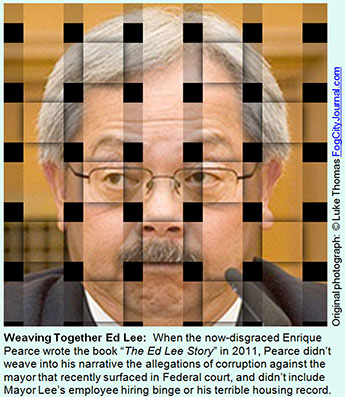 October
2015 at www.WestsideObserver.com
October
2015 at www.WestsideObserver.comMayor’s "Affordability Agenda" Inequities
Re-Elect the Mayor? You’re Kidding. Right?
Article in Press Printer-friendly PDF file
Westside Observer
 October
2015 at www.WestsideObserver.com
October
2015 at www.WestsideObserver.com
Mayor’s
"Affordability Agenda" Inequities
Re-Elect the
Mayor? You’re Kidding. Right?
by Patrick Monette-Shaw
Ever since being appointed Mayor five years ago in January 2011,
Ed Lee has distinguished himself as a court jester, often favoring
his billionaire backers when not plotting out his “legacy.”
After cycling through various buzzwords for his legacy — the “jobs-jobs-jobs” mayor, the “affordability agenda” mayor, and the mayor who “assumed” the middle-class were moving out of town and, therefore, San Francisco didn’t need to create “affordable housing” — do San Franciscans really need, let alone want, another four years of his so-called “consensus leadership” skills on top of the five years we’ve already suffered through?
As part of his jobs-jobs-jobs agenda, Lee appears to have potentially been on a City-jobs buying binge.
Given his plunging approval ratings, voters would be wise to elect anyone-but-Ed-Lee, or cast no vote for mayor. There’s plenty of upside in withholding your vote for mayor.
As I reported in the Westside Observer in September, Mayor Lee was quoted in Time magazine in January 2014 as saying “I don’t think we paid any attention to the middle class. I think everybody assumed the middle class was [sic: were] moving out” to explain why very little middle-income housing has been built during his tenure.
As recently as September 24, Emily Green reported in the San Francisco Chronicle Mayor Lee told the Chronicle’s editorial board he has to “balance out a sentimental numerical goal to a practical, realistic invitation to be innovative in the city,” referring to Supervisor Jane Kim’s initially proposed November 2014 ballot measure that would have required that 33% of housing construction be “affordable.”
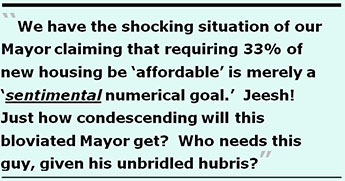 Now we have the shocking
situation of our Mayor claiming that requiring 33% of new housing
be ’affordable’ is merely a “sentimental
numerical goal.” Jeesh! Just how condescending will this
bloviated Mayor get? Who needs this guy, given his unbridled hubris?
Now we have the shocking
situation of our Mayor claiming that requiring 33% of new housing
be ’affordable’ is merely a “sentimental
numerical goal.” Jeesh! Just how condescending will this
bloviated Mayor get? Who needs this guy, given his unbridled hubris?
Lee’s Approval Ratings Droop
In just a short two-year period, Mayor Lee’s approval rating plunged nearly 30%, from 65% favorable approval in 2013 to just 38% as late as April 2015. Concomitantly, his disapproval ratings have soared by almost 20%, from 28% in January 2013 to 46% April 2015. For all anyone knows, his approval ratings may have plunged even further since last April, with an increase in his disapproval ratings. With numbers like these, who would vote for him?
The San Francisco Chronicle reported that 65% of likely voters had a favorable opinion of Mayor Lee in a poll commissioned by the San Francisco Chamber of Commerce conducted by David Binder Research in January 2013 among 500 likely voters. Binder’s 2013 poll showed Lee’s disapproval rating had risen to 28% from just 3% shortly after he was appointed in January 2011. Wow! A 25% increase in disapproval ratings within just two years.
The Chronicle then reported Lee no longer appeared to be an infallible mayor two years into his appointed term. The Chronicle suggested perhaps there was something to Lee’s toned-down, consensus-building “compromise” approach to governance as a “moderate,” even though Lee’s approval ratings were plunging, and his disapproval ratings soaring.
 By December 4, 2014
SFIST.com reported a SurveyUSA poll commissioned by
KPIX 5 showed Lee’s approval rating among another 500 likely
voters had slid to 47% (from 65%), with the same percentage saying
quality-of-life in the City was getting worse. The SurveyUSA poll
revealed 38% of respondents disapproved of Lee and 18% weren’t
sure.
By December 4, 2014
SFIST.com reported a SurveyUSA poll commissioned by
KPIX 5 showed Lee’s approval rating among another 500 likely
voters had slid to 47% (from 65%), with the same percentage saying
quality-of-life in the City was getting worse. The SurveyUSA poll
revealed 38% of respondents disapproved of Lee and 18% weren’t
sure.
On April 21, 2015, the San Francisco Examiner carried an Op-Ed by Larry Bush — a former Examiner reporter, former member of San Francisco’s Civil Grand Jury in 2012, a former speechwriter and policy adviser to then-Mayor Art Agnos, and a key leader in San Francisco’s good government watchdog, “Friends of Ethics” — in which Bush reported Lee’s approval rating drooped just four months later to 38%, with a corresponding disapproval rating of 46% and just 16% then unsure. Bush’s poll was conducted by Public Policy Polling, also with a sampling of over 500 potential voters.
Bush reported the Mayor’s approval rating varied across the City’s supervisorial districts.
In Katy Tang’s District 4, Lee had a 50% disapproval rating. In London Breed’s District 5, he had a 51% disapproval rating. In Supervisor Avalos’ District 11, Lee’s disapproval rating last April climbed to 63%. In Supervisor Scott Wiener’s Castro District 8, Lee’s disapproval was at 41%. And in Supervisor Farrell’s District 2, 47% of survey respondents disapproved of Lee’s performance. Voters in almost all districts strongly disapprove his performance.
While voters may “like” Mayor Ed Lee, by a significant margin they don’t approve of his job performance. As with many others, I like him personally. But I think his performance has been deplorable, and stinks on a number of levels.
And that’s pretty much the way voters all across the City viewed his performance last April.
“Jobs, Jobs, Jobs”: Patronage City Jobs?
Between the time Lee was appointed Mayor at the half-way point in FY 2010-2011 and the end of FY 2014-2015 in June 2015, the City’s payroll increased by a staggering 13.1%, from 34,576 employees to 39,122 employees, shown in Figure 1, an increase of 4,546 additional City employees.
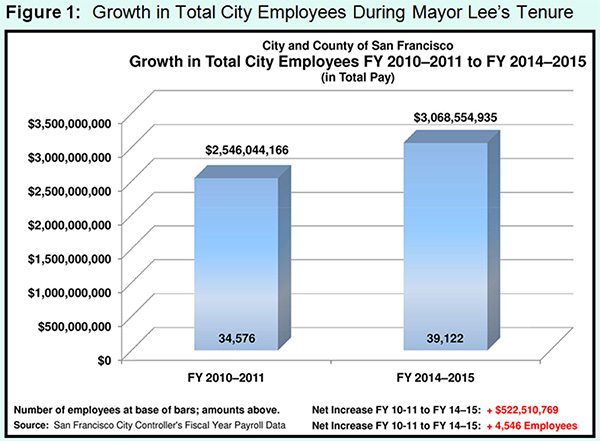
Could Mr. Lee have gone shopping for patronage jobs?
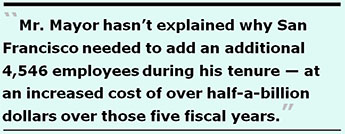 While the City likes
to paint a picture of a lower number of City employees, the City’s
fudged numbers convert part-time employees into so-called “full-time
equivalents,” or FTE’s. But in truth, at the end of
June 2015 there were a total of 39,122 full- and part-time employees
on the City’s payroll, costing an extra $522.5 million, on
an annual going-forward basis.
While the City likes
to paint a picture of a lower number of City employees, the City’s
fudged numbers convert part-time employees into so-called “full-time
equivalents,” or FTE’s. But in truth, at the end of
June 2015 there were a total of 39,122 full- and part-time employees
on the City’s payroll, costing an extra $522.5 million, on
an annual going-forward basis.
Why does San Francisco need these 4,546 additional City employees under Mayor Lee’s tenure?
The increase in the total number of City employees under his tenure has added over a half-billion dollars in total pay alone (base pay + overtime pay + “other” pay), but excludes the increase in benefits and retirement costs associated with the increased number of City employees.
Mr. Mayor hasn’t explained why San Francisco needed to add an additional 4,546 employees during his tenure — at an increased cost of over half-a-billion dollars over those five fiscal years — and hasn’t indicated how the functions of City government may have changed requiring increased employees to justify such largesse in the warm-bodies headcount.
 Cushy Management Positions
Cushy Management Positions
Digging deeper looking into the City Controller’s payroll database for comparisons between when Lee first took office and today, it turns out that of the added 4,546 employees, fully 2,971 of them — 65.4% — are employees earning over $100,000 annually, as shown in Figure 2.
The 2,971 new employees earning over $100,000 suck $491,869,027 — 94.1 % — of the increased $522,510,769 in payroll costs during Lee’s tenure as mayor shown in Figure 1 above. That’s a half-billion dollars in total pay alone, excluding fringe benefits and future retirement costs.
The 2,971 employees earning over $100,000 are 64.5% of new hires, but gobble 94.1% of the increased payroll.

 For that matter,
why did the Mayor need to hire 1,265 more employees earning between
$150,000 and $199,999 plus another 559 more employees earning
$200,000 and up?
For that matter,
why did the Mayor need to hire 1,265 more employees earning between
$150,000 and $199,999 plus another 559 more employees earning
$200,000 and up?
Combined, the 1,824 additional employees earning over $150,000 and up cost $345,405,936 — fully 66% of the $522.5 million increase in the City’s payroll.
Of the now 39,122 City employees, perhaps the Mayor is redirecting fatter salaries to the 32% who earn over $100K, not to the 68% of City employees who earn far less than $100K and who average just $48,715 in total pay.
Table 1 below shows that between citywide senior managers, and senior managers at MUNI, the Mayor added 129 such positions, at a cost of $30 million.

 Table 2 below shows
89 managers the Mayor added citywide, at a cost of $24.7 million,
including 31 additional Deputy Directors and Department Heads
at a cost of $7.5 million. Why did Mayor Lee need another 31 deputy
directors and department heads to run City government? What changed
in departmental missions that required adding such bloat in deputy
director and department head staff?
Table 2 below shows
89 managers the Mayor added citywide, at a cost of $24.7 million,
including 31 additional Deputy Directors and Department Heads
at a cost of $7.5 million. Why did Mayor Lee need another 31 deputy
directors and department heads to run City government? What changed
in departmental missions that required adding such bloat in deputy
director and department head staff?
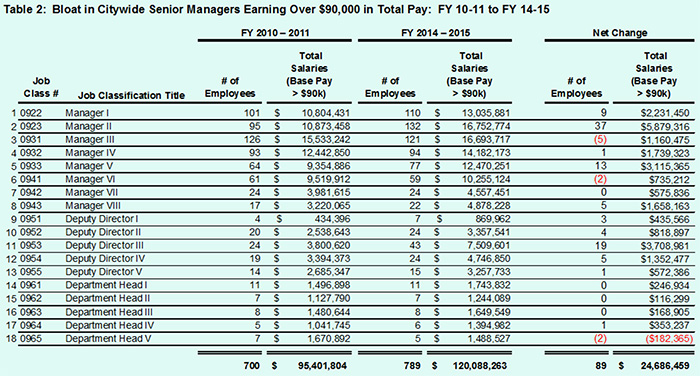
 Table 3 shows the
Mayor also added another 40 senior managers at MUNI, at a cost
of almost $5 million. Has the addition of this many managers improved
MUNI’s on-time performance, or reduced switchbacks?
Table 3 shows the
Mayor also added another 40 senior managers at MUNI, at a cost
of almost $5 million. Has the addition of this many managers improved
MUNI’s on-time performance, or reduced switchbacks?
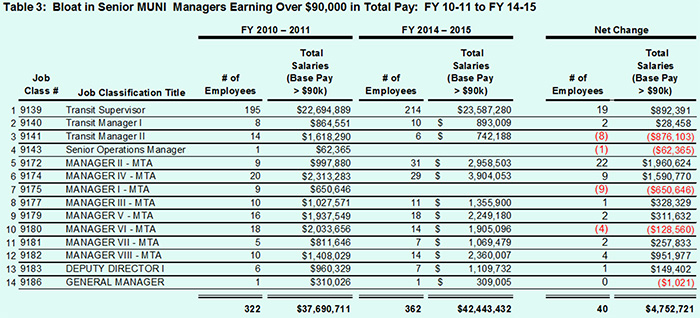
As Figure 3 shows, since 2003 when former City Supervisor Tom Ammiano first identified a problem with just 2,918 then-City employees earning greater than $90,000 annually, we now have 11,886 more employees who do — yes, nearly twelve thousand more — costing $1.7 billion more than in 2003.

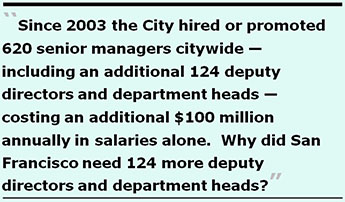 San Franciscans should
never forget Lee’s shopping binge hiring an additional 4,546
employees may eventually prove to be an “unsustainable”
expense for future mayor’s when the tech “bubble”
eventually bursts, and the City goes into years of budget deficits.
San Franciscans should
never forget Lee’s shopping binge hiring an additional 4,546
employees may eventually prove to be an “unsustainable”
expense for future mayor’s when the tech “bubble”
eventually bursts, and the City goes into years of budget deficits.
As Table 4 below shows, since 2003 the City hired or promoted 620 senior managers citywide — including an additional 124 deputy directors and department heads — costing an additional $100 million annually in salaries alone, excluding fringe benefit and eventual retirement cots.

Can anyone explain why San Francisco needed 124 more deputy directors and department heads, 25% — 31 — of whom were added during Lee’s five-year tenure?
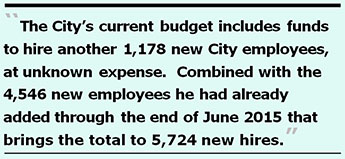 How has the increase
of 620 additional senior manager city (excluding senior MUNI managers)
across this dozen-year period improved City government or services
to citizens?
How has the increase
of 620 additional senior manager city (excluding senior MUNI managers)
across this dozen-year period improved City government or services
to citizens?
The Mayor’s hiring binge isn’t cooling off. The Chronicle published a story on October 9, 2015 reporting that the City’s current budget includes funds to hire another 1,178 new City employees (or more if these are full-time equivalent positions) at unknown expense. Combined with the 4,546 new employees he had added during his tenure through the end of June 2015, that brings the total to 5,724 new hires, with more likely to follow.
Allegations of Corruption
When San Franciscan’s reached for their morning copy of the San Francisco Examiner on August 5, they were roundly, and uniformly, shocked to read an exposé of allegations of public corruption — featuring photos of Mayor Lee and Board of Supervisors president London Breed — plastered across the front page.
The story’s headline on page four reading “Mayor allegedly took bribes in exchanges for favors” came as a complete shock to most San Franciscans, despite rumors of City Hall corruption that have circulated for decades.
 Evidence presented
in the racketeering prosecution of Raymond “Shrimp Boy”
Chow reportedly alleged implication of a wide array of City and
State leaders — including Mayor Lee — involving alleged
bribery schemes, pay-to-play plots, campaign contribution money
laundering, and state construction contract rigging, according
to a filing in Federal court the day before by “Shrimp Boy’s”
attorneys.
Evidence presented
in the racketeering prosecution of Raymond “Shrimp Boy”
Chow reportedly alleged implication of a wide array of City and
State leaders — including Mayor Lee — involving alleged
bribery schemes, pay-to-play plots, campaign contribution money
laundering, and state construction contract rigging, according
to a filing in Federal court the day before by “Shrimp Boy’s”
attorneys.
“Shrimp Boy’s” attorneys requested the case against him be dismissed due to the alleged selective prosecution of him, but not prosecution of Mayor Lee, among others.
The court filing quotes and references FBI wiretaps, body wires, agents, and sources. Then-San Francisco Human Rights Commissioner Nazly Mohajer was recorded on tape as saying former Mayor Willie Brown taught Ed Lee how to do business. Mohajer explained on tape how she laundered Lee’s campaign money. She went on to say Lee took $20,000 in campaign contributions, gifts and trips during his first four months in office, and said “Lee knew he was taking the money illegally.”
 The next day, on
August 6, San Franciscans were even more shocked to read Jonah
Owen Lamb’s hardcopy article in the Examiner titled “Lee
allegedly knew of illegal exchanges.” Lamb reported “Mayor
Ed Lee knew his underlings were arranging campaign money laundering
schemes, and they were caught saying as much on FBI wires …”
The next day, on
August 6, San Franciscans were even more shocked to read Jonah
Owen Lamb’s hardcopy article in the Examiner titled “Lee
allegedly knew of illegal exchanges.” Lamb reported “Mayor
Ed Lee knew his underlings were arranging campaign money laundering
schemes, and they were caught saying as much on FBI wires …”
Although prosecutors filed a motion on August 5 to seal the court documents released the day before by “Shrimp Boy’s” attorneys, U.S. District Court Judge Charles Breyer eventually ruled not to seal the records, since the court filings had already been made public.
In addition to Mohajer, former Human Rights Commission staff member Zula Jones was also caught on FBI wires saying Lee “knew he was taking the money illegally.” For his part, the Mayor claimed he had run a clean campaign and just a week before, the San Francisco’s Ethics Commission had closed its records on Lee’s campaign.
 Obviously, the Ethics
Commission could not have known of the corruption allegations
that only surfaced a week after it closed the books
on Lee’s campaign when “Shrimp Boy’s” attorneys
filed its court motion on August 4.
Obviously, the Ethics
Commission could not have known of the corruption allegations
that only surfaced a week after it closed the books
on Lee’s campaign when “Shrimp Boy’s” attorneys
filed its court motion on August 4.
Reportedly, Lee allegedly met with an undercover FBI agent on April 6, 2012 and discussed the first $10,000 illegal “straw donor” contributions to break up one person’s contributions exceeding donor limits into smaller contributions. During an April 25, 2012 phone call, Mohajer spoke ill of the Mayor, saying she found San Francisco politicians are extremely corrupt and that Ed Lee “is worse than all of them.”
San Francisco Chronicle Muddies the Waters
Racing to Lee’s defense, San Francisco Chronicle gossip columnists Matier and Ross reported on August 6 that both George Gascón and City Attorney Dennis Herrera may or may not be conducting their own independent investigations. Matier and Ross reported other of their sources confirmed that investigations by the District Attorney and City Attorney are underway, although specific targets of the investigations were unclear.
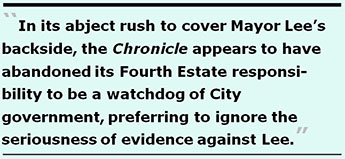 Matier reported that
several months before August, an anonymous complaint was filed
with San Francisco’s Ethics Commission against former San
Francisco School Board president Keith Jackson, who has already
plead guilty to the Federal racketeering case involving campaign
fundraising.
Matier reported that
several months before August, an anonymous complaint was filed
with San Francisco’s Ethics Commission against former San
Francisco School Board president Keith Jackson, who has already
plead guilty to the Federal racketeering case involving campaign
fundraising.
Matier and Ross (M&R) reported that Ethics Commissioner Peter Keane said that the Ethics Commission had began looking into the anonymous complaint, but was told by the City Attorney and District Attorney to “just cool the Ethics Commission’s part of it” while other investigations were going on. Keane said “The [Ethics Commission] can get back into it, and probably will.”
M&R reported Mohajer and Jones had subsequently introduced the undercover agent to the mayor during two separate meetings.
You’d think the Mayor would remember all of these meetings. You would be wrong, because Lee claims he only vaguely recalled the meetings, since they were indistinguishable from hundreds of other meetings he has with people wanting to do business with the City.
 This begs the question:
How many other meetings has Lee attended with other campaign donors
who may also be used to flouting campaign contribution regulations
that the FBI used in this apparent sting operation?
This begs the question:
How many other meetings has Lee attended with other campaign donors
who may also be used to flouting campaign contribution regulations
that the FBI used in this apparent sting operation?
A second article in the Chronicle on August 6 racing to Mayor Lee’s defense noted Chow’s attorneys accused U.S. Attorney Melinda Haag of failing to prosecute Lee and other City officials because they were politically connected and because of the “perceived negative consequences of going after them.”
On August 7, the Chronicle published an editorial in print, attempting to absolve Mayor Lee, initially titled “Hot spotlight on City Hall.” The editorial’s title was creatively re-edited to read “City Hall charges can’t be ignored but must be weighed carefully” when it appeared on-line. The Chronicle has done everything it can to ignore — and bury — the serious charges revealed by “Shrimp Boy’s” attorneys.
In its abject rush to cover Ed Lee’s backside, the Chronicle appears to have abandoned its Fourth Estate responsibility to be a watchdog of City government, preferring to ignore the seriousness of evidence against Lee caught on FBI wires.
 Indeed, the Chronicle
has a nasty habit of first publishing articles and editorials
in print using one headline, and then deliberately changing the
headlines in its on-line content, making the hardcopy articles
extremely difficult for other media watchdogs and average citizens
to track down via Google and the Internet. Second, the Chronicle
has another nasty habit of charging subscription fees to get at
its so-called “premium” content, stupidly believing
readers don’t retain original published in-print reports
and editorials. It charges the subscription fees, in part, to
restrict access to stories it has already published in print editions,
in effect censoring access to stories it willingly printed to
sell hardcopies.
Indeed, the Chronicle
has a nasty habit of first publishing articles and editorials
in print using one headline, and then deliberately changing the
headlines in its on-line content, making the hardcopy articles
extremely difficult for other media watchdogs and average citizens
to track down via Google and the Internet. Second, the Chronicle
has another nasty habit of charging subscription fees to get at
its so-called “premium” content, stupidly believing
readers don’t retain original published in-print reports
and editorials. It charges the subscription fees, in part, to
restrict access to stories it has already published in print editions,
in effect censoring access to stories it willingly printed to
sell hardcopies.
San Francisco Examiner Keeps the Story Alive
Thankfully, it’s far easier to hunt down San Francisco Examiner articles on the Internet following publication, but it, too, annoyingly often changes article headlines between original publication and on-line content, creating an unnecessary hurdle to locate articles on-line.
On August 10, the Examiner reported the Mayor and his campaign have vigorously denied any wrongdoing since the evidence surfaced in court records on August 4, and announced that tainted campaign contributions would be donated to the City without identifying how much would be donated.
If there was no wrongdoing, Lee shouldn’t have to refund a penny of it. Since he claimed to be refunding it, he must realize it was, of course, clearly tainted money that court documents suggest he was aware of back in 2012 when he reportedly met with an undercover FBI agent to help retire almost $300,000 in campaign debts from his 2011 campaign.
With that much campaign debt to retire, you’d think the mayor would remember the names of prominent donors he met with to tray to raise that kind of cash.
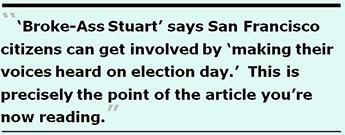 Zula Jones, for her
part, had been indicted in an earlier FBI corruption probe of
City Hall. She was indicted in 2000 on 16 counts of fraud for
allegedly scheming to defraud the City’s’ Minority Contracting
Program; the charges were eventually dropped in 2002.
Zula Jones, for her
part, had been indicted in an earlier FBI corruption probe of
City Hall. She was indicted in 2000 on 16 counts of fraud for
allegedly scheming to defraud the City’s’ Minority Contracting
Program; the charges were eventually dropped in 2002.
In 2015, the Ethics Commission forwarded a complaint about Mohajer’s activities to the District Attorney’s office. The Examiner reported again on August 10 that Mohajer reportedly told Keith Jackson — a former School Board member who has plead guilty to racketeering charges, along with former State Senator Leland Yee — that she finds San Francisco politicians corrupt, and that Ed Lee is “worse than all of them.”
On August 11, Examiner columnist Joe Fitzgerald Rodriguez published an informative rationale of why the media holds a special responsibility to hold City Hall accountable. After he read the blather in the Chronicle’s August 7 editorial defending Mayor Lee, Rodriguez wrote “my jaw dropped to the floor” when the Chronicle jumped straight to Lee’s defense.
Rodriguez noted:
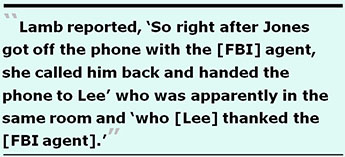 On August 14, Jonah
Owen Lamb reported in the Examiner that “Shrimp
Boy” Chow’s August 4 motion also asserted that Annemarie
Conroy — who is currently in charge of External Affairs for
the U.S. Attorney’s Office and has connections to San Francisco
City politicians — “used her position of influence to
cull [some] political figures out of the prosecution, and selectively
prosecute others.” In other words, Mr. Lamb reported Ms.
Conroy appears to have spared prosecution of Mayor Lee.
On August 14, Jonah
Owen Lamb reported in the Examiner that “Shrimp
Boy” Chow’s August 4 motion also asserted that Annemarie
Conroy — who is currently in charge of External Affairs for
the U.S. Attorney’s Office and has connections to San Francisco
City politicians — “used her position of influence to
cull [some] political figures out of the prosecution, and selectively
prosecute others.” In other words, Mr. Lamb reported Ms.
Conroy appears to have spared prosecution of Mayor Lee.
San Franciscans may recall that Ms. Conroy [not to be confused with Mayor Lee’s billionaire backer, Ron Conway] was wholly unqualified to be the director of San Francisco’s Office of Emergency Services and Homeland Security, but was appointed to that position by then-Mayor Gavin Newsom in 2004, given her political connections as a former City Supervisor. In 2006, she was demoted from director of San Francisco’s Office of Emergency Services and Homeland Security to Deputy Director of Emergency Services in the then- newly-created Department of Emergency Management under then-director Laura Phillips. By 2007 Ms. Conroy had resigned, given mounting public scrutiny of her clear lack of qualifications to serve in these capacities.
On August 27, 2015 the Examiner carried its “Broke-Ass Stuart” (a.k.a., Stuart Schuffman) columnist’s article on how to fix San Francisco’s corruption problem. Stuart — who is running for election as mayor in November — observed:
Stuart’s three-point plan includes:
1. We need to elect our elected officials. Stuart notes that when City Supervisor’s quit or leave, the Mayor gets to appoint their replacement, and noted that 23 Supervisors have been appointed in this manner. Stuart calls for a special election to replace the Supervisors, instead of allowing the Mayor to appointment interim replacements.
2. San Francisco needs a public advocate. Stuart says “the public advocate is a badass, whose job is to investigate corruption on all levels and represent the people against the evil armies of bureaucracy.” Stuart says this isn’t a novel idea, since “many other major cities like New York, Seattle and L.A. already have one.”
3. We need to start giving a shit. Stuart says this is probably the most important one. He says “The people and media of San Francisco can’t just accept this as business as usual. We need to get mad and we need to take action.” He says San Francisco citizens can get involved by “making their voices heard on election day.”
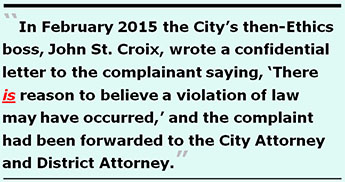 This is precisely
the point of the article you’re now reading, and what voters
need to do on November 3, 2015 by not casting a vote for Ed Lee
as mayor.
This is precisely
the point of the article you’re now reading, and what voters
need to do on November 3, 2015 by not casting a vote for Ed Lee
as mayor.
On August 28, the Examiner carried a follow-up article by Jonah Owen Lamb that reported Judge Breyer declined to dismiss the charges against “Shrimp Boy” Chow, despite Chow’s lawyers assertion that their motion for discovery “was motivated by their belief that it will show the FBI investigation into political corruption in San Francisco was stopped when it got too close to The City’s leaders.”
Lamb reported the FBI agent wanted to make sure the mayor knew all the money [$20,000 in campaign donations] was coming from him. Lamb reported, “So right after [Zula] Jones got off the phone with the [FBI] agent, she called him back and handed the phone to [Mayor] Lee” who was apparently in the same room and “who [Lee] thanked the man [the undercover FBI agent] for his contribution.”
Apparently, we’re to believe the Mayor can not only not remember having met with the undercover FBI agent in person, we’re also expected to believe Lee has creatively forgotten he spoke on the phone with the same FBI agent?
Shockingly, the Chronicle also reported on August 28 that one of “Shrimp Boy’s” defense lawyers, J. Tony Serra, said documents provided to Chow’s lawyers and disclosed in the August 4 filing show “This is a political case.” Serra said Lee and other officials investigated by the FBI were spared because they’re “too big to fall.”
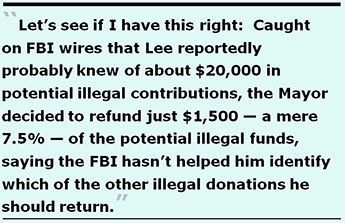 More shockingly,
as early as August 9, after the allegations against the Mayor
surfaced in the Examiner on August 4, Chronicle
columnists Matier and Ross conveniently claimed on the Mayor’s behalf that Lee
had returned $1,500 of the illegal campaign contributions to the
City. Matier and Ross wrote:
More shockingly,
as early as August 9, after the allegations against the Mayor
surfaced in the Examiner on August 4, Chronicle
columnists Matier and Ross conveniently claimed on the Mayor’s behalf that Lee
had returned $1,500 of the illegal campaign contributions to the
City. Matier and Ross wrote:
M&R noted on August 9 that in February 2015 — after a citizen’s complaint was filed with the Ethics Commission raising questions about Mohajer’s fundraising activities and reappointment to the Human Rights Commission — the City’s then-Ethics boss, John St. Croix, wrote a confidential letter to the complainant saying, “There is reason to believe a violation of law may have occurred [emphasis added].”
St. Croix added the matter had been referred to the City Attorney and District Attorney, and “both offices have advised our office that they will investigate the matter.”
Let’s see if I have this right: Caught on FBI wires that Lee reportedly probably knew of about $20,000 in potential illegal campaign contributions, the Mayor decided to refund just $1,500 — a mere 7.5% — of the potential illegal funds, saying the FBI hasn’t helped him identify which of the other illegal donations he should return, as if his campaign treasurer can’t figure this out himself. Matier and Ross are apparently OK with this, despite their journalist rules of ethics to expose such public wrongdoing, given returning 7.5% on the dollar has to be totally embarrassing and a new low, even for a Mayor.
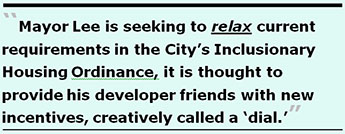 “Dialing” for Developer Incentives
“Dialing” for Developer Incentives
As I reported in the Westside Observer in September 2015, there are many problems with the $310 million Affordable Housing Bond measure on the November ballot, since the legal text of Prop. “A” is so vaguely worded, stating that several planned uses “may be allocated” funding, rather than explicitly stating funds “shall be expended” for specific stated purposes and clear uses.
Couple this vagueness with the fact that the Mayor’s Office of Housing and Community Development has sole discretion on how to spend funds in the 2012 voter-approved $1.5 billion Housing Trust Fund, and you have a recipe for disaster.
Developer Incentives: The Preliminary “Dial”
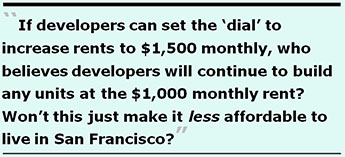 On September 9, Emily
Green reported in the San Francisco Chronicle
that Mayor Lee has announced a plan to build or rehabilitate 10,000
housing units by 2020. Lee is seeking to relax
current requirements in the City’s Inclusionary Housing Ordinance,
it is thought to provide his developer friends with new incentives,
creatively called a “dial.”
On September 9, Emily
Green reported in the San Francisco Chronicle
that Mayor Lee has announced a plan to build or rehabilitate 10,000
housing units by 2020. Lee is seeking to relax
current requirements in the City’s Inclusionary Housing Ordinance,
it is thought to provide his developer friends with new incentives,
creatively called a “dial.”
Mayor Lee, joined by Supervisors Mark Farrell and Katy Tang, introduced amendments to the Inclusionary Housing Ordinance on September 8 proposing “incentives” for developers, purportedly to build more below-market-rate housing.
Ms. Green’s article noted the relaxed requirements would allow developers to build affordable units for a broader range of incomes. She wrote: “For example, instead of building 10 units that would be required to rent at $1,000 a month, developers could build 20 [units] to rent at $1,500 a month.”
Great! If developers can set the “dial” to increase rents to $1,500 monthly, who believes developers will continue to build any units at the $1,000 monthly rent? Won’t this just make it less affordable to live in San Francisco? How is relaxing these requirements going to help foster “inclusionary” housing?
 And developers could
add up to two stories to a building in exchange for increasing
the number of units to rent or sell to low- and middle-income
residents.
And developers could
add up to two stories to a building in exchange for increasing
the number of units to rent or sell to low- and middle-income
residents.
Ms. Green didn’t go into further detail about Lee’s proposed changes to the Inclusionary Housing Ordinance. [Where Green learned this is not known, since the actual amendments to the Inclusionary Housing Ordinance do not seem to directly address rents that can be charged.]
The “Dial” Worsens
But on September 15, Laura Dudnick at the San Francisco Examiner provided more details about the legislation Lee and Supervisors Farrell and Tang introduced as amendments to the City’s Inclusionary Housing Ordinance to the Board of Supervisors. Details of what else will be “relaxed” are troubling, but typical of this mayor and “moderate” supervisors.
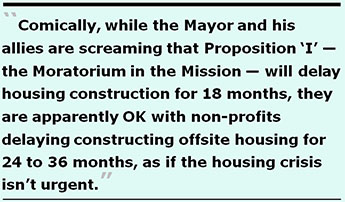 The legislation apparently
allows developers to change the “dial” of what they
will build. As in press “D” for “Dialing for Dollars.”
The package of incentives developers can reset the “dial”
for inclusionary housing apparently features:
The legislation apparently
allows developers to change the “dial” of what they
will build. As in press “D” for “Dialing for Dollars.”
The package of incentives developers can reset the “dial”
for inclusionary housing apparently features:
 If this “dial”
is approved by the full Board of Supervisors and signed into
law by the mayor, you can almost guarantee that developers will
“dial out” producing inclusionary housing for those
earning between 50% and 80% of AMI.
If this “dial”
is approved by the full Board of Supervisors and signed into
law by the mayor, you can almost guarantee that developers will
“dial out” producing inclusionary housing for those
earning between 50% and 80% of AMI. Expanded Details of the “Dial”
Expanded Details of the “Dial”
For re-setting these “dials,” developers will be allowed to increase density, and perhaps bulk, by adding an additional two to three floors to building projects, apparently bypassing the Planning Commission.
These “dials” are meant to reward the Mayor’s developer friends, but are likely to lead to greater displacement.
Details in the “dial” amendments Lee, Farrell, and Tang, introduced are very worrisome.
Among them, non-profit developers will not only be allowed up to three years to build the housing, they will also be able to base their developments not on the number of units created, but on the square footage of units built. The enabling legislation states on page 34 that “Non-Profit Partner Projects,” may meet their “off-site” requirements on a square footage basis, and could provide just 20% of their off-site units based on the square foot floor areas as their principal projects.
That means that instead of 20% of the number of on-site units built will have to be built off-site, just 20% of the square footage of the on-site units may have to be built off-site. Perhaps as an unintended consequence, this will just incentivize developers to lower the square footage of each of, say, 100 on-site market-rate units, so that instead of having to build 20 off-site units, they may possibly only have to build 10 units, each based on the smaller square footage of the market-rate units.
This may be a “win-win” for Non-Profit Partners, or the non-profit housing mafia, but it may turn out to be a very bad loss for off-site housing seekers forced into ever-smaller square footage “micro-units,” at ever escalating rents.
 A second problem
that emerges from reading the text of the official proposed legislation
is that both the on-site and off-site “Dial Up tables”
contained on pages 27-28 and pages 40-41, respectively, show that
the AMI targets for both ownership and rental targets stipulate
that much of the data concerning AMI thresholds is “not available,”
which, therefore, does not clearly or explicitly describe to San
Franciscans what will be required of developers and speculators.
A second problem
that emerges from reading the text of the official proposed legislation
is that both the on-site and off-site “Dial Up tables”
contained on pages 27-28 and pages 40-41, respectively, show that
the AMI targets for both ownership and rental targets stipulate
that much of the data concerning AMI thresholds is “not available,”
which, therefore, does not clearly or explicitly describe to San
Franciscans what will be required of developers and speculators.
How can AMI information “not be available” before the Board of Supervisors is supposed to prudently analyze and then vote on the wisdom of this proposed ordinance, and its intended purposes and potential unintended consequences?
Not only may developers be able to choose which “dial” they want to Dial for Dollars, they may also be able to claim they based their pick on unavailable AMI percentage thresholds approved by the Board of Supervisors for the 1% of developers, not for us “us-es” in the 99% being forced into smaller square footage housing units, or displaced out of town entirely.
Sweet! Sweet for developers and real estate speculators. Not so much for the rest of us!
A Modern “Westside Story": Proposed “Density Bonus”
Worse than the Hatfield’s vs. the McCoy’s, and worse than the mid-1950’s Broadway play West Side Story highlighting feuds between the Jets vs. the Sharks, San Francisco’s West Side is quickly becoming the new turf war in San Francisco.
Whereas the “dial” legislation seeks to increase AMI levels to 120%, a new proposal by the Mayor seeks to push it to 140% of AMI. This comes from the same Mayor who whined to the Chronicle’s editorial board, that a 30% requirement for affordable housing is merely a “sentimental” number. Apparently, he now wants us to be “sentimental” about households earning up to $142,000, or 140% of AMI. And he wants to bifurcate how the 30% mix of affordable units will be divvied up.
 On September 29,
2015, the San Francisco Chronicle published an article
titled “Lee wants deal to spur more low-cost units,”
in which J.K. Dineen reported developers will be allowed to build
“an extra two stories of height on projects that include
30 percent affordable housing, and an extra three stories on 100
percent affordable developments.”
On September 29,
2015, the San Francisco Chronicle published an article
titled “Lee wants deal to spur more low-cost units,”
in which J.K. Dineen reported developers will be allowed to build
“an extra two stories of height on projects that include
30 percent affordable housing, and an extra three stories on 100
percent affordable developments.”
The second proposed ordinance from the Mayor again with Supervisor Katy Tang — legislation separate from the Inclusionary Housing Ordinance “dial” legislation — calls for bifurcating the 30% “affordable housing goal” into 18% of units to be affordable to families making between 120% of AMI ($122,000) and 140% of AMI ($142,000) for a family of four, and allowing just 12% of the housing to be “catered” to people who have low- to moderate-incomes. How nice of the mayor to cater to us “us-es”!
The density bonus is being touted as for being along transit corridors “upzoned” for density.
Although Dineen’s article starts out saying the Mayor’s proposed legislation would affect neighborhoods across the west side of San Francisco, it’s not yet known whether the legislation will eventually apply everywhere in the City, not just on the west side. It’s likely to spread from the west side rapidly.
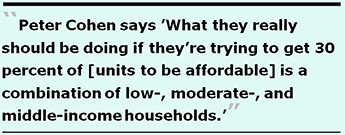 Dineen quoted Fernando
Marti, a co-director of the Council of Community Housing Organizations,
who said his organization would stay neutral on this proposal,
because some people feel the density bonus should target lower
income levels, particularly for a single-person where an individual
(not just families of four) is making 140% of AMI ($100,000) who
should be able to qualify for the affordable for-sale units.
Dineen quoted Fernando
Marti, a co-director of the Council of Community Housing Organizations,
who said his organization would stay neutral on this proposal,
because some people feel the density bonus should target lower
income levels, particularly for a single-person where an individual
(not just families of four) is making 140% of AMI ($100,000) who
should be able to qualify for the affordable for-sale units.
Marti was quoted as saying, “We question if that is the income level we should be developing [housing] programs for.” In addition, Marti has concerns up-zoning would ultimately make it more expensive for non-profit developers looking to acquire sites for 100% affordable projects.
A day later, in a September 30, 2015 article in the San Francisco Examiner published in print with a title “Mayor, supe introduce affordable housing program” — a title that was changed to “SF seeks to further incentivize developers to build below-market-rate homes” on the Examiner’s web site — Laura Dudnick reported that the Affordable Housing “Bonus” Program would change the requirement of units that are affordable to households earning 55% of AMI to 90% of AMI to 12%, and increase housing units for households earning up to 120% of AMI and 140% of AMI to 18%. There’s the bifurcation again.
The Examiner quoted the second co-director of the Council of Community Housing Organizations, Peter Cohen, who said the Mayor’s new below-market-rate housing proposal should include households making 90% of AMI. Cohen said:
 That appears to be
lost on Mayor Lee, Supervisor Tang, MOHCD, and perhaps the full
Board of Supervisors.
That appears to be
lost on Mayor Lee, Supervisor Tang, MOHCD, and perhaps the full
Board of Supervisors.
As the Examiner reported on September 21, the “Google bus” problem of tech buses transporting high-tech workers from San Francisco to the Silicon Valley has led to increased evictions and higher rents all across San Francisco, and includes the West Side of town, according to research by the Anti-Eviction Mapping Project, a story I’ll pursue in next month’s Westside Observer.
As density increases along West Side transit corridors, West Side residents should brace for more “Google buses” driving up rents and increasing evictions on the West Side. You’ve been warned.
Small Site Acquisition
Don’t believe campaign mailers you may receive that state passage of the $310 million Affordable Housing Bond measure will re-fill the reportedly now-depleted citywide Small Site Acquisition fund.
As I also reported in September, documents from the Affordable Housing Bond’s Budget and Finance Subcommittee changed the planned spending parameters of the Mission Neighborhood Acquisition portion of the bond for Mission District neighborhood site acquisition to also include unit rehabilitation and predevelopment, so it’s unclear whether the planned $50 million will be dedicated solely to site acquisition.
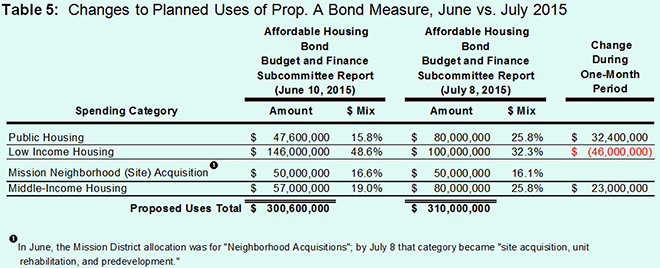
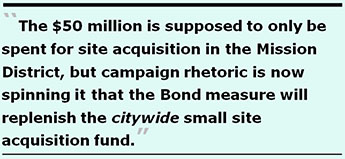 The $50 million is
supposed to only be spent for site acquisition in the Mission
District, but campaign rhetoric is now spinning it that the Bond
measure will replenish the citywide small site acquisition
fund. The legal text that will appear in the November
2015 voter guide describing the $310 million Affordable Housing
bond measure states proposed uses include subsection 3-H, for
acquiring, preserving, or developing affordable housing in the
Mission Area Plan.
The $50 million is
supposed to only be spent for site acquisition in the Mission
District, but campaign rhetoric is now spinning it that the Bond
measure will replenish the citywide small site acquisition
fund. The legal text that will appear in the November
2015 voter guide describing the $310 million Affordable Housing
bond measure states proposed uses include subsection 3-H, for
acquiring, preserving, or developing affordable housing in the
Mission Area Plan.
However, subsection 3-H also contains the vague language that this planned use “may be allocated,” not “shall be expended,” so there’s no guarantee that small sites will even be acquired in the Mission District, let alone replenish the citywide small sites acquisition fund.
Beside subsection 3-H, there is nothing anywhere else in the legal text of the bond measure that involves funding small sites acquisition.
Between the $89.42 million and $73.99 million collected since 1998 in Inclusionary Affordable Housing fees and the Affordable Housing Job Linkage fees, respectively — for a combined total of $176.68 million, including $13 million in interest earned — MOHCD has been on the hook to set aside 10% ($9 million to $18 million, at minimum) into the Small Sites Fund, with nothing barring it from dedicating more funding from other sources for Small Sites acquisition.
 But it’s not
yet known how much MOHCD actually put into the Small Sites Fund,
or what it may have spent those funds on, if at all. Amazingly,
the initial, and now new amendments to the Inclusionary Affordable
Housing Ordinance restricts the Small Sites Fund from exceeding
more than $15 million in that fund at any one time.
But it’s not
yet known how much MOHCD actually put into the Small Sites Fund,
or what it may have spent those funds on, if at all. Amazingly,
the initial, and now new amendments to the Inclusionary Affordable
Housing Ordinance restricts the Small Sites Fund from exceeding
more than $15 million in that fund at any one time.
These days, $15 million isn’t going to go far in snapping up potential housing sites, whether in the Mission District or elsewhere citywide.
After this article was submitted for publication, requests for additional public records were released. It turns out the Small Sites Fund — Subsections 415.5(f)(2)(A) – (D), Affordable Housing Fee — was added to Planning Code Section 415.5 by the Board of Supervisors on December 14, 2010, which was approved on December 23, and became effective on January 22, 2011 as a sub-fund of the Citywide Affordable Housing Fund established by the Inclusionary Affordable Housing Program.
 The changes effective
January 2011 required MOHCD to designate a new fund and separately
account for 10% of all inclusionary housing fees it receives under
Section 415.5 by diverting the 10% until the Small Sites Fund
reached $15 million, and to produce annual reports to the Board
of Supervisors showing the amount of fees dedicated to the Small
Sites Fund and how the funds were used. Nothing in the ordinance
prohibits MOHDC from spending other funds on Small Sites.
The changes effective
January 2011 required MOHCD to designate a new fund and separately
account for 10% of all inclusionary housing fees it receives under
Section 415.5 by diverting the 10% until the Small Sites Fund
reached $15 million, and to produce annual reports to the Board
of Supervisors showing the amount of fees dedicated to the Small
Sites Fund and how the funds were used. Nothing in the ordinance
prohibits MOHDC from spending other funds on Small Sites.
Because the ordinance was adopted in the middle of FY 10–11, MOHCD should have established this mandated sub-fund in its FY 11–12 budget. But Risa Sandler in the City Controller’s Office confirmed the fund wasn’t set up expeditiously. She wrote:
Prior to asking the City Controler about the fund, a records request had been submitted to MOHCD requesting the annual reports for FY 13–14, FY 14–15, and any other annual reports produced. In response, MOHCD brazenly supplied its overall departmental annual report — not the Small Funds annual report requested — for FY 12–13 and FY 13–14, which contained few details about the Small Site Fund, but did state that the Small Site Program launched on July 24, 2014 with an initial allocation of $3 million. This put it into FY 14–15, not “late in FY 13–14” as the Controller’s Office asserted.
 The Controller’s
Office subsequently provided unclear data for FY 14–15, showing
$5.85 million appeared to be available in the Small Sites Fund
for the period ending in June 2015, including a negative balance
of $5.2 million that was carried forward from the previous year
(possibly suggesting overspending of the previous budget in FY
13–14) and $4.15 million in unallacoated General Funds. Confusing
matters more, the data provided by the Controller’s Office
showed no amount was expended in FY 14–15 in the “Actuals:
Year-to-Month” line for expenditures.
The Controller’s
Office subsequently provided unclear data for FY 14–15, showing
$5.85 million appeared to be available in the Small Sites Fund
for the period ending in June 2015, including a negative balance
of $5.2 million that was carried forward from the previous year
(possibly suggesting overspending of the previous budget in FY
13–14) and $4.15 million in unallacoated General Funds. Confusing
matters more, the data provided by the Controller’s Office
showed no amount was expended in FY 14–15 in the “Actuals:
Year-to-Month” line for expenditures.
The Controller’s Offfice suggested I contact MOHCD to obtain the incomplete data, but MOHCD had by that time provided only its departmental annual report. MOHCD’s accounting of, and records of, the Small Site Fund’s revenue and expenditures appears to be in complete shambles, providing no transparency or accountability almost six years later.
Here we are four years after the Small Sites Fund was to have been set up beginning in FY 11-12, and five-and-a-half years after the enabling legislation was first passed, and MOHCD has no records it will produce to show revenues into, and expenditures made from, the sub-fund, and simply points to a nearly useless departmental annual report. And now five months after the close of FY 14-15 last June, MOHCD refuses to provide any data about expenditures in that fiscal year or any other for over five years into the legislative mandate to create and separately account for this sub-fund.
 A Mayor Chasing His Tail for a “Legacy”
A Mayor Chasing His Tail for a “Legacy”
First he claimed to be the “jobs, jobs, jobs” Mayor, which he achieved, in part, by hiring 4,546 new City employees. Then he became the “consensus mayor.” Then he became desperate, hoping his legacy would be that he helped build the new Warriors stadium jutting out from a pier out along the Embarcadero. Big mistake.
Then we heard he was the “affordability agenda” Mayor, somewhat remotely concerned about solving income inequality disparities, in part by pushing a so-called “sharing economy” with Airbnb, NextDoor, and other rubes.
 Then we read his
admission in Time magazine in January 2014 that he and
other City Hall planners had “assumed” the middle class
were moving out of town and they apparently didn’t need to
do anything about reversing the phenomena.
Then we read his
admission in Time magazine in January 2014 that he and
other City Hall planners had “assumed” the middle class
were moving out of town and they apparently didn’t need to
do anything about reversing the phenomena.
So it comes with some hilarity that on September 21 Joe Fitzgerald Rodriguez reported in the San Francisco Examiner that Mayor Lee apparently told Examiner staff writer Joshua Sabatini that he’s been called lot of names, but “I do enjoy being called the housing mayor.”
Really? This is more like unbridled hilarity. What housing? Right?
Has the Mayor checked his own housing record? The record shows that under his watch:
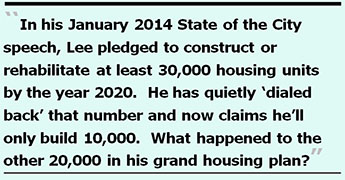 The Examiner
reported March 15, 2015 that when asked about City Hall’s
plans to create desperately needed middle-class rental housing,
Olson Lee, Director of the Mayor’s Office of Housing, replied,
“We don’t have a program right now to build middle-income
rental housing.” Goes right along with the Mayor having
told Time magazine a year earlier “everybody assumed
the middle-class was moving out [of the City].” For a “Housing
Mayor,” not having a middle-income rental housing program,
either, is rich!
The Examiner
reported March 15, 2015 that when asked about City Hall’s
plans to create desperately needed middle-class rental housing,
Olson Lee, Director of the Mayor’s Office of Housing, replied,
“We don’t have a program right now to build middle-income
rental housing.” Goes right along with the Mayor having
told Time magazine a year earlier “everybody assumed
the middle-class was moving out [of the City].” For a “Housing
Mayor,” not having a middle-income rental housing program,
either, is rich!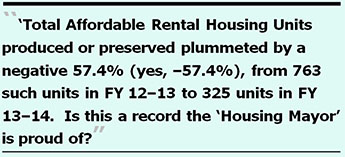 According to Table
2 on PDF page 42 in MOHCD’s most recent annual report, the total Affordable Rental
Housing Units produced or preserved plummeted by a negative 57.4%
(yes, -57.4%), from 763 such units in FY 12–13 to 325 units
in FY 13–14. For that matter, considering just the total
Affordable Rental Housing Units preserved during this same period,
the decline was more pronounced at a negative 87% (that’s
-87%), down from 556 units preserved in FY 12–13 to just
72 units preserved in FY 13–14. Is this a record the “Housing
Mayor” is proud of?
According to Table
2 on PDF page 42 in MOHCD’s most recent annual report, the total Affordable Rental
Housing Units produced or preserved plummeted by a negative 57.4%
(yes, -57.4%), from 763 such units in FY 12–13 to 325 units
in FY 13–14. For that matter, considering just the total
Affordable Rental Housing Units preserved during this same period,
the decline was more pronounced at a negative 87% (that’s
-87%), down from 556 units preserved in FY 12–13 to just
72 units preserved in FY 13–14. Is this a record the “Housing
Mayor” is proud of? Mayor’s Legacy Includes “L’Affaire
Mirkarimi”
Mayor’s Legacy Includes “L’Affaire
Mirkarimi”
Voters should not forget San Francisco’s mainstream daily news media reported only the most superficial information about the issues underlying the official misconduct charges Ed Lee wrongly filed against Sheriff Ross Mirkarimi in March 2012, as I noted in several articles, including here.
Had Lee succeeded at creatively re-interpreting clear language in the San Francisco City Charter’s definition of what constitutes “official misconduct,” each and every City employee could have been charged with the same capriciousness as Lee charged Mirkarimi. The four City supervisors who saw through this ruse and voted to allow Mirkarimi to keep his job reached the correct interpretation of the law, as Mr. Brill presented: The charges against the Sheriff — developed by the City Attorney on the Mayor’s behalf — did not rise to the City Charter’s definition of official misconduct.
 A dispassionate analysis
of the Ethics Commission’s handling of Sheriff Ross Mirkarimi’s
case ripped apart any semblance of logic in the Mayor’s persecution
of Mirkarimi. Initially published anonymously in September 2012,
the author (who later revealed himself to be San Francisco lawyer
Eric A. Brill) noted even Mayor Lee’s attorneys conceded
that Ethics Commissioner Paul Renne’s argument — that
any and all misconduct is official misconduct, whether it relates
to official duties or not — “would cause San Francisco’s
’official misconduct’ law to fail [a basic] constitutional
test,” (that to be constitutional, a law must be sufficiently
clear that people required to obey it can easily determine what
conduct is prohibited). It would have been an example of the precise
opposite of the rule of law, it would more appropriately
be called the “law of rulers.”
A dispassionate analysis
of the Ethics Commission’s handling of Sheriff Ross Mirkarimi’s
case ripped apart any semblance of logic in the Mayor’s persecution
of Mirkarimi. Initially published anonymously in September 2012,
the author (who later revealed himself to be San Francisco lawyer
Eric A. Brill) noted even Mayor Lee’s attorneys conceded
that Ethics Commissioner Paul Renne’s argument — that
any and all misconduct is official misconduct, whether it relates
to official duties or not — “would cause San Francisco’s
’official misconduct’ law to fail [a basic] constitutional
test,” (that to be constitutional, a law must be sufficiently
clear that people required to obey it can easily determine what
conduct is prohibited). It would have been an example of the precise
opposite of the rule of law, it would more appropriately
be called the “law of rulers.”
The initially-anonymous analysis was provided to Ethics Commissioners, the full Board of Supervisors, and probably to the Mayor and his legal team. In the end, four City Supervisors — David Campos, John Avalos, Jane Kim, and Christina Olague — voted to reinstate Mirkarimi, handing the Mayor an embarrassing defeat. Stupidly, Supervisor Scott Wiener and then-Supervisor David Chiu, both Harvard-educated lawyers, voted to sack Mirkarimi — ignoring the clear legal analysis that Brill had adroitly authored.
 Mayor Lee wasted
$1.3 million in taxpayer funds racked up in City Attorney time
during the City’s inept proceedings on behalf of the mayor
trying to persecute and oust Sheriff Mirkarimi.
Mayor Lee wasted
$1.3 million in taxpayer funds racked up in City Attorney time
during the City’s inept proceedings on behalf of the mayor
trying to persecute and oust Sheriff Mirkarimi.
For this reason alone, voters should consider voting for Mirkarimi for Sheriff. Vicki Hennessey might turn out to be a great Sheriff, but the Mayor’s deplorable treatment of Mirkarimi, and the Mayor’s refusal to even speak to the Sheriff during the past three years, is nothing short of a childish fit of pique.
Mirkarimi gets my vote, partly out of empathy for the soap opera Lee wrongly put him — and the body politic — through for over nine months, and partly for Mirkarimi’s many accomplishments as Sheriff, including a recent award from Harvard University, an awards ceremony the Mayor boycotted attending due to his unending pique.
Upside in Not Voting for a Mayor
 Voters have plenty
of reason to dislike Ed Lee’s job performance, as reflected
in his approval ratings. As I’ve reported, Lee’s quote
in Time magazine that “everybody assumed the middle-class
was moving out,” pretty much says it all regarding his failures
to develop affordable housing in San Francisco.
Voters have plenty
of reason to dislike Ed Lee’s job performance, as reflected
in his approval ratings. As I’ve reported, Lee’s quote
in Time magazine that “everybody assumed the middle-class
was moving out,” pretty much says it all regarding his failures
to develop affordable housing in San Francisco.
Adding insult to injury, Lee’s having told the San Francisco Chronicle’s editorial board that the Prop K goal to build 33% of new housing as affordable housing is a “sentimental numerical goal” that he needs to balance that out with “a practical, realistic invitation to be innovative” is pure hubris. This is precisely the sort of insulting, gibberish, deconstruction spin control San Franciscans have grown tired of hearing from this incumbent.
I recommend that you cast no vote for mayor at all. This will not only send a signal to Lee that voters totally disapprove of his performance, it will also help make placing citizen’s signature petition initiatives for future municipal elections on the ballot easier.
Consider this: In the November 2011 election, only 197,242 of 464,380 registered San Francisco voters bothered to vote. Voter turnout in 2011 was just 42.47%, up from 35.6% voter turnout in the November 2007 election when only 149,465 ballots were cast by then 419,598 registered voters.
 Ed Lee garnered just
59,775 votes in the first round of ranked choice votes in 2011,
which represented just 30.3% of the total 197,242 votes cast.
By the time ranked choice Round 12 concluded, fully 55,625 ballots
were exhausted, leaving just 141,617 votes counted toward the
election for a mayor. Of the 141,617 ballots counted, Lee snagged
just 84,457 shuffled ranked-choice votes, giving him a win with
59.6% of the ballots that qualified.
Ed Lee garnered just
59,775 votes in the first round of ranked choice votes in 2011,
which represented just 30.3% of the total 197,242 votes cast.
By the time ranked choice Round 12 concluded, fully 55,625 ballots
were exhausted, leaving just 141,617 votes counted toward the
election for a mayor. Of the 141,617 ballots counted, Lee snagged
just 84,457 shuffled ranked-choice votes, giving him a win with
59.6% of the ballots that qualified.
Given election results in the election of Gavin Newsom for mayor in 2007, just 7,168 valid signatures of registered San Francisco voters were required in 2011 to qualify a proposed signature petition initiative for the ballot, since City Charter §14.101 stipulates the signature threshold is based on 5% of the entire vote cast for all candidates for mayor at the last preceding regular municipal election.
Based on the turnout for Ed Lee for mayor in 2011, the signature threshold climbed to 9,862 for the November 2014 election — an increase of nearly 2,700 additional signatures to qualify an initiative for the ballot.
Notably, under ranked choice voting, if you skip filling in a ranked choice slot, a quirk in San Francisco election law transfers your ranked choices. When first-choice ranking is skipped as required, San Francisco Charter Sec. 13.102 states: “If a voter casts a ranked-choice ballot but skips a rank, the voter’s vote shall be transferred to that voter’s next ranked choice,” whether that’s what you intended to do, or not.
By not voting at all for mayor in November 2015, you will help drive down the number of signatures required to place citizen signature-petition initiatives on future municipal ballots simply by not casting any vote for mayor.
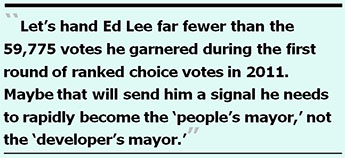 But if you feel compelled
to vote for a candidate for mayor, remember than the election
is ranked choice. Consider voting for these three candidates,
in ranked order: #1: Francisco Herrera, #2: Amy Farah Weiss, and #3: Stuart Schuffman. Or you could write me
in as a write-in candidate for Rank #1, and not cast any votes
for Ranks 2 and 3, if you’re really compelled to vote for
someone for mayor.
But if you feel compelled
to vote for a candidate for mayor, remember than the election
is ranked choice. Consider voting for these three candidates,
in ranked order: #1: Francisco Herrera, #2: Amy Farah Weiss, and #3: Stuart Schuffman. Or you could write me
in as a write-in candidate for Rank #1, and not cast any votes
for Ranks 2 and 3, if you’re really compelled to vote for
someone for mayor.
Just don’t vote for Ed Lee, who needs to be sent a message voters have completely had it with his housing policies that favor speculators and developers, which is fueling massive displacement of long-time San Franciscans.
After all, the hubris-filled Mayor’s snide remark that requiring 33% of new housing to be affordable is merely a “sentimental number” is insulting to those who’ve already been displaced out of town, and to those who soon will be.
Let’s hand Ed Lee far fewer than the 59,775 votes he garnered
during the first round of ranked choice votes in 2011. Maybe that
will send him a signal he needs to rapidly become the “people’s
mayor,” not the “developer’s mayor.”
Monette-Shaw is an open-government
accountability advocate, a patient advocate, and a member of California’s
First Amendment Coalition. He received the Society of Professional
Journalists-Northern California Chapter’s James Madison Freedom of Information Award in the Advocacy category in March 2012. Feedback: monette-shaw@westsideobserver.
Postscript
After I posted this article on line, the San Francisco Examiner published an editorial accompanying it’s endorsements for the November 3, 2015 election on Thursday, October 15, noting that Mayor Lee had refused to meet with the Examiner’s editorial board. The refusal was likely the handiwork of his campaign manager, Bill Barnes.
Its editorial read, in part:
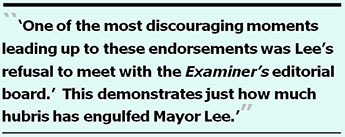 One
of the most discouraging moments leading up to these endorsements
was Lee’s refusal to meet with the Examiner’s editorial
board. His campaign declined our request to have Lee talk with
us alongside his challengers, noting the mayor was scheduled
to debate the others in an Oct. 8 forum sponsored by the League
of Women Voters. ‘That forum will be convened by an impartial
organization and will be open to the public - we prefer that
format,’ his campaign manager offered.
One
of the most discouraging moments leading up to these endorsements
was Lee’s refusal to meet with the Examiner’s editorial
board. His campaign declined our request to have Lee talk with
us alongside his challengers, noting the mayor was scheduled
to debate the others in an Oct. 8 forum sponsored by the League
of Women Voters. ‘That forum will be convened by an impartial
organization and will be open to the public - we prefer that
format,’ his campaign manager offered. “Aloof and disengaged”
is certainly a part of the problem, but this demonstrates just
how much hubris has engulfed Mayor Lee.